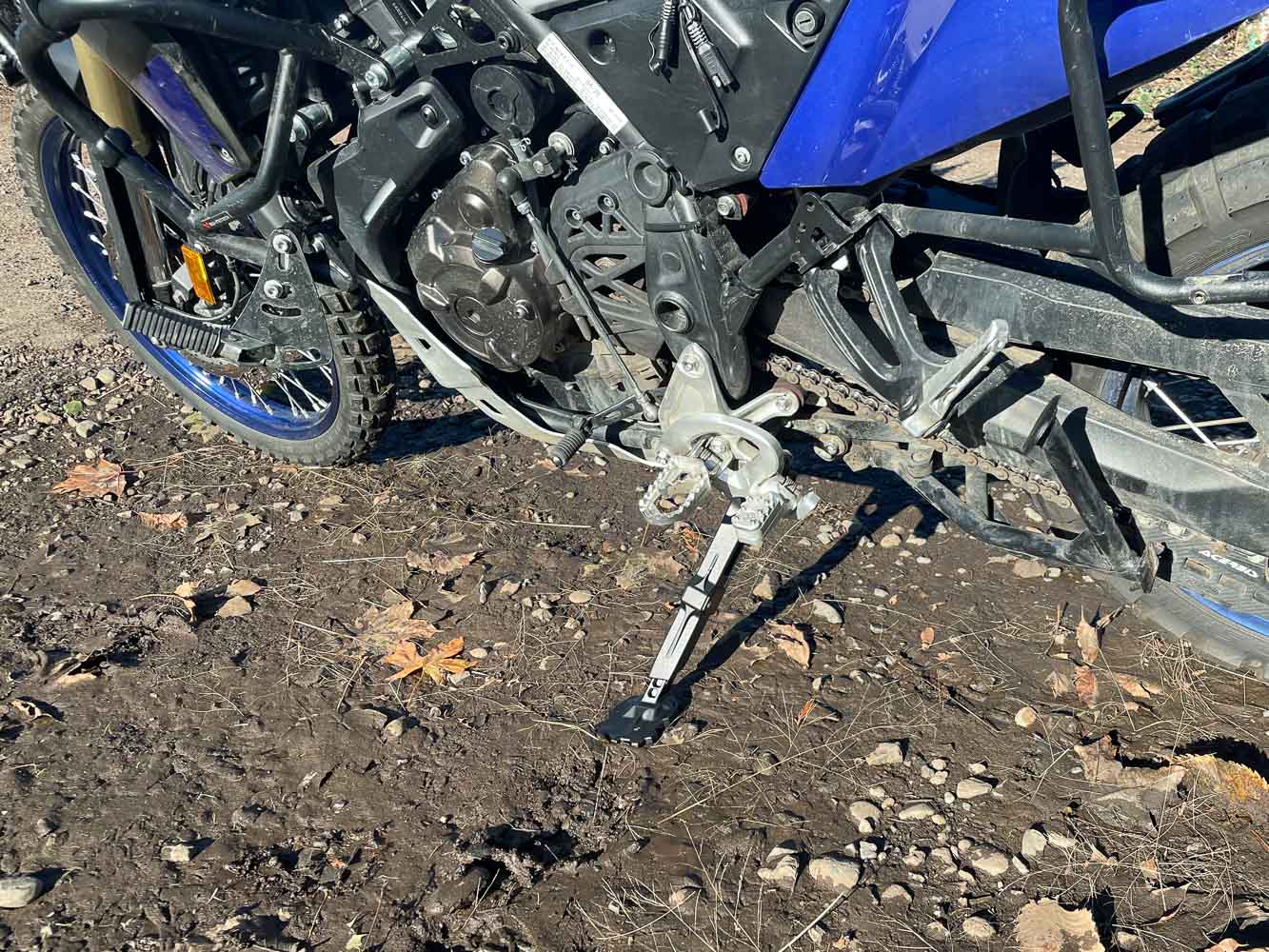The Ultimate Motorcycling Yamaha Ténéré 700 Project Bike was delivered with it lowered 0.8 inches from stock—just enough to keep me off my tip toes at a stop. However, that less than an inch of lowering results in the kickstand holding the bike near vertical, or at least that is what it seems like as I gingerly mount and dismount. I have tipped over to the high side many times because I couldn’t get sure footing quick enough. Even being careful to look for level locations before dismounting, such as at a gas station pump, the Ténéré 700 would drop to the high side due to a gust of wind.
The solution to the problem is a shorter kickstand, but how much shorter?
The AltRider Adjustable Aluminum Side Stand has seven length settings over a three-inch range—from one inch longer than stock to two inches shorter. The broad adjustment range satisfies riders who have lowered their Ténéré 700s, as well as those riders blessed with adventure bike long legs. The stock kickstand is too short on a lifted Ténéré 700, causing the bike to lean excessively.
With several lowering settings, the AltRider adjustable stand gives me the ability to dial in just the right kickstand lean angle for my setup and preference. If I am running 80/20 street tires, my lean angle will be different than when I mount new tall knobbies. When my panniers are fully loaded and I have camping gear strapped to the back of the bike, the kickstand angle changes.
Installation is straightforward, though it does require some planning. The kickstand exchange took me about 30 minutes, including stopping to take photos.
You start by removing the stock kickstand. The two main bolts holding the stock kickstand are threadlocked, and are under the bike facing away from you if you are working from the kickstand side. For those of you with a bike lift, this will be an easier job. If you don’t have a lift, you will need to secure your bike vertically and block it from rolling as you break those bolts free. If you can reach the bolts with your bike on its centerstand, block the front end, so you don’t move the bike off the stand when breaking the bolts free.
AltRider includes a spring puller in the kit, and it works great. The greater tension of the AltRider spring is evident when you stretch it to catch the pin on the kickstand, and safety glasses are mandatory.
Be aware of the location of the rotation pin of the side stand switch. It is tiny and easily missed. Notice how the pin fits into the pivot base of your current sidestand; make sure you put it into the new AltRider kickstand in the same orientation.
Deploying the AltRider Adjustable Side Stand requires a heel grab of the stand, as there is no point sticking out to hook your heel on—I missed it the first time due to muscle memory. However, I haven’t missed since seeing that it just takes my heel moving a little deeper in towards the swing arm. When deployed, the convex bottom of the huge foot does a good job of self-leveling for maximum stability.
To change the length of the kickstand after installation, you will need to either have a friend hold the bike vertically, put it on its centerstand, or lean it against a wall—you can’t have any weight on it when adjusting the length. Remove the two 4mm hex socket head bolts that hold the two pieces together. If you have made the kickstand fairly short, you will also have to take off the spring hook, which requires unlatching the spring with the included spring puller. The adjusting process takes about two minutes.
Fixed-length kickstands are the one size fits all solution to a multi-variable issue. After installation, your lean angle is unchangeable. The fixed-length “lowered” kickstands are just a little too short for my liking, making it difficult to get my bike upright when I have parked on a slight slope with a full tank of gas and a stuffed tank bag. I wanted something in-between stock and fixed lowered length. With an adjustable kickstand, I can set the length to my preference.
The $175 price tag for the AltRider Adjustable Aluminum Side Stand is $56 more than the fixed-length Camel ADV Products T7 Camel Toe Sidestand I tested earlier on in the life of the Ultimate Motorcycling Yamaha Ténéré 700 Project Bike. However, if you need adjustability, the AltRider unit is well worth the premium.
Like all products from this Seattle-based company, the kickstand is made to take the rigors of off-road use, and there is a Honda Africa Twin version in addition to the Ténéré 700 model I tested. The adjustability of the AltRider Adjustable Aluminum Side Stand makes it stand out from other kickstands.

























![2024 MV Agusta Enduro Veloce Review [18 Fast Facts]](https://ultimatemotorcycling.com/wp-content/uploads/2024/04/2024-mv-agusta-enduro-veloco-review-fast-facts-28-218x150.webp)

